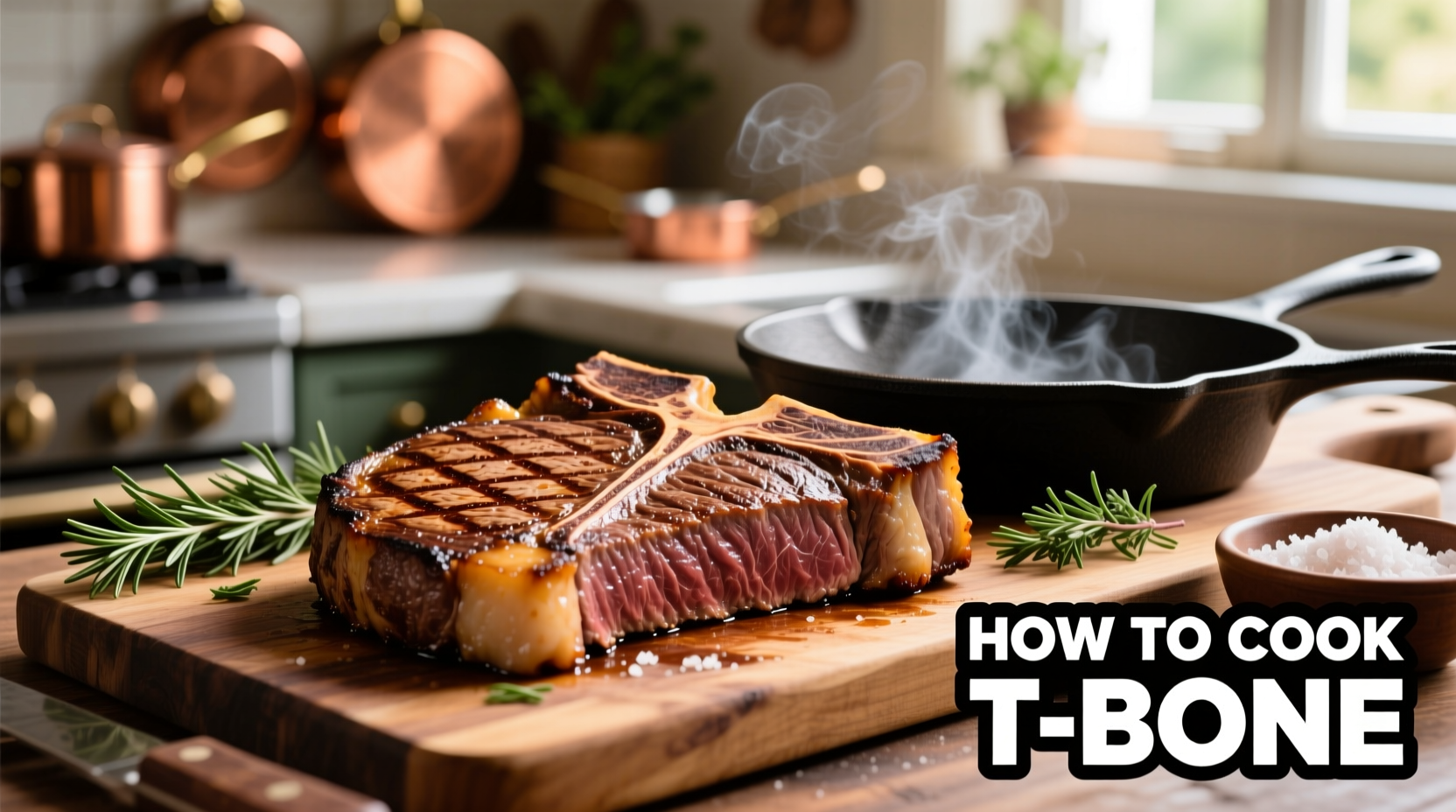Perfectly cook a T-bone steak by bringing it to room temperature, seasoning generously, searing at 450°F for 3-4 minutes per side, then finishing in the oven at 400°F until reaching your desired internal temperature (120°F for rare, 135°F for medium-rare). Always rest for 10 minutes before slicing for maximum juiciness.
There's nothing quite like a perfectly cooked T-bone steak—juicy, flavorful, and cooked exactly to your preference. Whether you're using your grill, cast-iron skillet, or oven, this guide delivers restaurant-quality results at home. In just 30-45 minutes, you'll transform a premium cut into a memorable meal that impresses even seasoned steak enthusiasts.
Why T-Bone Stands Out Among Steak Cuts
The T-bone steak earns its name from the distinctive T-shaped lumbar vertebra bone that divides two premium cuts: the tender filet mignon on one side and the flavorful New York strip on the other. This dual-cut advantage gives you the best of both worlds—the tenderness of filet and the robust beefiness of strip steak. According to the USDA Agricultural Marketing Service, T-bone steaks must contain at least 1.25 inches of filet portion to qualify for the designation, making it distinct from the smaller filet-containing porterhouse.
Selecting Your Perfect T-Bone
Before you start cooking how to cook T-bone steak, choose wisely. Look for these characteristics:
- Marbling: Fine white fat streaks throughout the meat—this melts during cooking, basting the steak from within
- Color: Bright cherry red indicates freshness; avoid brown or gray tones
- Thickness: Opt for 1.5-2 inch steaks for optimal control over doneness
- Grade: USDA Prime offers the best marbling, followed by Choice
| Doneness Level | Internal Temperature | Visual Characteristics | Touch Test |
|---|---|---|---|
| Rare | 120-125°F | Bright red center, cool | Feathery soft like cheek |
| Medium-Rare | 130-135°F | Warm red center | Yields like chin |
| Medium | 140-145°F | Pink center | Firm like forehead |
| Medium-Well | 150-155°F | Small pink center | Very firm |
| Well-Done | 160°F+ | No pink, gray throughout | Extremely firm |
Source: USDA Food Safety and Inspection Service temperature guidelines
Essential Preparation Steps
Proper preparation makes the difference between good and exceptional steak:
Temperature Equilibrium
Remove your T-bone from the refrigerator 45-60 minutes before cooking. This critical step ensures even cooking throughout. A cold center leads to overcooked exteriors before the inside reaches your desired temperature. The American Meat Science Association confirms that bringing meat to room temperature reduces cooking time variance by up to 30%.
Seasoning Strategy
Keep it simple: coarse kosher salt and freshly ground black pepper. Apply 1 teaspoon of salt per pound of steak at least 40 minutes before cooking—this allows the salt to penetrate rather than just sit on the surface. For enhanced flavor, add crushed garlic or fresh herbs during the last few minutes of cooking. Avoid sugary rubs that burn at high searing temperatures when learning how to cook T-bone steak properly.

Three Proven Cooking Methods
Cast-Iron Skillet Method (Indoor)
- Preheat oven to 400°F
- Heat cast-iron skillet over high heat for 5 minutes until smoking
- Add 1 tablespoon high-smoke point oil (avocado or grapeseed)
- Sear steak 3-4 minutes per side until deep brown crust forms
- Transfer skillet to oven and cook 6-8 minutes for medium-rare
- Flip halfway through oven time for even cooking
Grill Method (Outdoor)
- Prepare two-zone fire: one side high heat (450-500°F), one side medium (350°F)
- Sear over direct heat 4-5 minutes per side
- Move to indirect heat and continue cooking with lid closed
- Rotate steak 90 degrees halfway through searing for attractive crosshatch marks
- Use tongs, not a fork, to avoid piercing and losing juices
Reverse Sear Method (For Thick Steaks)
- Preheat oven to 275°F
- Place steak on wire rack over baking sheet
- Cook until internal temperature reaches 110°F (about 45-60 minutes)
- Heat skillet to smoking point
- Sear 90 seconds per side for perfect crust
Critical Resting Period
Resist the temptation to cut immediately! Resting allows the muscle fibers to reabsorb juices. For a T-bone steak:
- Cover loosely with foil
- Restate 8-10 minutes (1 minute per 100g of steak)
- Place on warm plate, not cold surface
- During this time, internal temperature will rise 5-10°F (carryover cooking)
According to culinary research from the Culinary Institute of America, skipping the resting period can result in up to 30% juice loss when slicing.
Avoid These Common T-Bone Mistakes
- Moving too soon: Let steak release naturally from the cooking surface before flipping
- Overcrowding: Cook one steak at a time in skillet for proper sear
- Guessing doneness: Always use an instant-read thermometer for accuracy
- Cutting across the grain: Slice parallel to the T-bone for optimal tenderness
- Ignoring the bone: The bone insulates adjacent meat—check temperature in multiple spots
Serving Suggestions That Elevate Your T-Bone
Complement your perfectly cooked steak with these classic pairings:
- Compound butter (garlic-herb or blue cheese)
- Simple pan sauce using deglazed fond
- Roasted vegetables (asparagus, mushrooms, or Brussels sprouts)
- Creamy mashed potatoes or roasted fingerlings
For the best experience when learning how to cook T-bone steak, serve immediately after resting while the crust remains crisp and interior is warm. Remember that T-bone's unique structure means the filet side cooks faster than the strip side—slice carefully to enjoy both textures at their peak.











 浙公网安备
33010002000092号
浙公网安备
33010002000092号 浙B2-20120091-4
浙B2-20120091-4